A wine and food fairyland
Article and photos © 2004 by Randy Buckner
April 2004
Saturday/Sunday
The flight from Seattle, Washington to Frankfurt, Germany was uneventful although very long (13 hours). The Frankfurt airport is huge, yet it is very easy to navigate your way through the terminals like a seasoned traveler. In no time we claimed our luggage, zipped through customs, took the skyway from terminal 2 to terminal 1 to meet up with friends, and then found our way to the van that we had rented through Auto Europe before leaving on our trip to Europe.
The next hurdle, a three hour drive to Riquewihr, Alsace, France, went by with equal aplomb. The autobahn is a wonderfully maintained highway with dizzying speed limits that would greatly please the most ardent Mario Andretti fan. Driving less than 140 kph will have people buzzing by you on all sides like a swarm of angry bees. In what seemed like no time, we were at our exit for Alsace. Heading west a few short kilometers we crossed over the historic Rhine River into the lovely Alsace region of France.
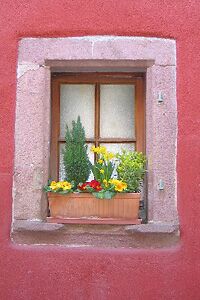 Alsace window box |
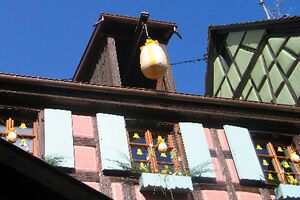 Easter eggs hang from Alsace home |
We passed through many villages on our way to Riquewihr, each with its own special charm. Common to all are the centrally located churches, their spires reaching towards the heavens with a sense of grace. Ever-present Easter egg colored homes, many of them hundreds of years old, sport massive beams in their plaster/stucco structure. Most are adorned with wood shutters and tatted curtains displaying Alsatian themes.
Riquewihr is a quaint town surrounded by massive rock walls. Ancient brick streets add to the ambience of the village. We soon arrived at our hotel, the St. Nicolas, which offers both comfort and value. We were warmly greeted by Monsieur Schneider, who speaks much better English than I speak French. Tired though we were, we quickly unpacked and headed for the town center.
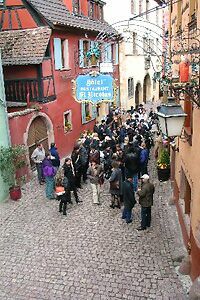 |
| View from window at Hotel St. Nicolas |
Giving in to the sensory overload, we returned to the hotel, freshened up, and then drove to the nearby village of Bergheim to dine at Winstub du Sommelier. Appetizers of foie gras paté, escargot, and onion tart were washed down by pichets (500 ml pitchers) of Gewurztraminer. Main courses included pike perch with pasta, pork with Pinot Noir sauce, and trout with lentils, accompanied by the 1997 Trimbach Frederick Emile Riesling and 2000 Kientzler Giesberg Riesling. Crème Bruleé and Framboise topped off the evening.
Our appetites sated, we returned to the hotel suffering from the effects of jet lag. We were soon curled up in our beds, fast asleep, with dreams of the coming day on Route des Vins dancing in our heads. The appointments at Trimbach and Kientzler floated in and out of our of our dream state.
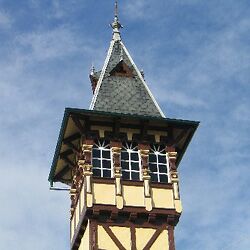 |
| Spire at Trimbach |
Feeling refreshed after a night of sleep, we had the typical breakfast of croissant, French bread, butter, soft cheese, and coffee, and then it was wine time! Navigating the Route des Vins is very easy. Signs are well marked to each village, and should you miss a turn, just go around the ever-present traffic circles and try it again. The bottom line is to know the name of the village that the desired winery is located in. We were headed for Ribeauvillé, home of Maison Trimbach, arguably one of the best in Alsace, and certainly one of my favorites.
The Trimbach family has been making wines in Alsace since 1626 when Jean Trimbach settled in Riquewihr and established a wine business. Successive generations have only improved on the Trimbach name.
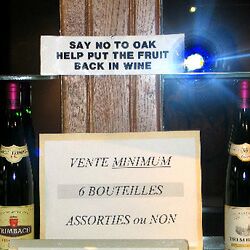 |
| Gotta love Trimbach |
The winery is easy to find with its spire tower. We were cheerfully greeted by Annie (last name escapes me), who welcomed us into the tasting room, where she poured us a total of twelve wines (notes follow). Every wine was at least very good, many were exceptional. This speaks highly of the house. We purchased six of the Reserve wines as we left since these particular wines are not imported to the USA. We also made a mental note to contact our retailers in order to obtain some of the imported wines.
While in Ribeauvillé, we stopped at Zum Pfifferhüs for lunch. We passed around appetizers of escargot, Quiche Lorraine, and paté. We checked choucroute off of our list here, always a favorite. We washed everything down with pichets of Riesling.
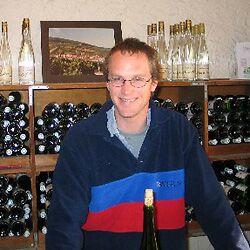 |
| Thierry Kientzler |
Five generations have carried on the tradition of winemaking at Kientzler. All wines are made from their own fruit. Andre´s son, Thierry Kientzler, states that they like to make their Rieslings consistently dry. They taste and compare the Rieslings with previous vintages, striving to have as little variation as possible from vintage to vintage.
Thierry greeted us at the door and then proceeded to take us through their line of wines. One of the pleasures of Alsace is that you never feel hurried during a tasting. Thierry poured us seventeen wines (notes follow), ranging from Chasselas to Selection de Grains Nobles Gewurztraminer. All were very good to exceptional as well. Six more bottles found their way into my Styrofoam shippers as we bid Kientzler ado, again making a mental note to find a source of their wines back home.
We returned to our hotel in Riquewihr to freshen up and then we walked to the town center, stopping at Le Bistrot, where we had our obligatory Muenster tarté flambé with pichets of Gewurztraminer. This is a wonderful pairing that never fails to please. A dessert of banana tarté flambé finished off the evening and then it was time to turn in for the night.
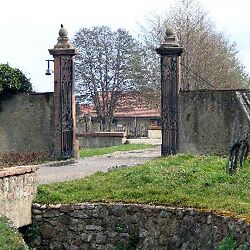 |
| Part of the Clos at Weinbach |
The next morning we had our usual breakfast and then we were off to Kaysersberg to keep our appointment with the Faller women of Domaine Weinbach. We were warmly greeted by Colette and Catherine, with Laurence dropping in later to extend a welcome. They have always made us feel right at home.
The vineyard or parts thereof, date back to the 9th century. The estate was established by the Capuchin monks in the early 17th century, which was called Clos des Capucins after the rock wall (clos) that surrounds the vineyard.
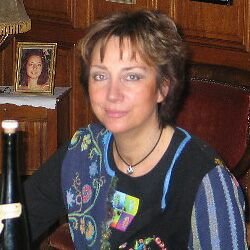 |
| Catherine Faller |
We were ushered to a dining table in their home, where Catherine proceeded to open nine of their wines for us, ranging from Muscat to Gewurztraminer VT (notes follow). She explained the vintage effects on their specific vineyards and talked about the very hot 2003 vintage. All wines poured were excellent to outstanding. Without a doubt, Weinbach ranks in the top five houses of Alsace and many of their wines grace my cellar. I left with six more prized bottles for my shippers, now almost full.
We stopped for lunch at the Weinstube Chambard in Kaysersberg. White asparagus was just in -- hooray! We had the dish served around the table with different sauces, but the mousseline sauce was the clear winner, although the garlic mayonnaise butter sauce was pretty tasty. This was all accompanied by pichets of Muscat, which matched quite well with the asparagus.
The afternoon was saved for shopping. Alsace makes beautiful local pottery that is intensely colored with local scenes adorning them. Most places will not ship the pottery so bring your own bubble wrap. French cotton lingerie is somewhat expensive but worth every penny. In the northwest part of Ribeauvillé you will find the Beauville factory, where you can find wonderful table linens made of vibrant 100% French cotton. Prices are about one-half of those found in retail stores. Be sure to pick up some of the wonderful local paté to take home with you as well.
The evening was spent at my favorite restaurant in the area, Sarment d´Or. They deserve a one star rating, but selfishly I am glad that they remain off of that radar screen. Prices remain very reasonable and the food and service are always impeccable. Serge, our waiter and sommelier, is world class. The opening volley was pan seared foie gras in a rich duck reduction sauce paired with a 1998 Trimbach Seigneurs Gewurztraminer -- a match made in heaven. Next came langoustine salad accompanied by 2001 Trimbach Riesling which was nice but the langoustines lacked a little texture. The stunning main courses included Leg of Lamb Pyrenees with wild mushrooms, chicken breast in cream sauce with morel mushrooms, and venison in a rich veal reduction sauce. A 1999 Lamy Burgundy accompanied all of the dishes quite well. The obligatory cheese cart followed with several "stinky cheeses." Trying to outdo themselves, the dessert was delivered to the table with aplomb. The Grand Marnier soufflé was pure heaven, as much a delight to look at as it was to eat. Oh man, let that belt out a notch! A wonderful evening was had by all.
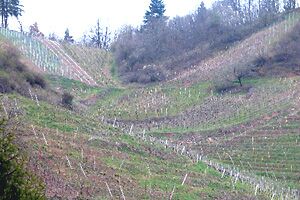 |
| Vineyards at Boxler |
Wednesday morning was devoted to Boxler. After our usual round of breads we set out for the vineyard. This small eighteen acre wine property is located at the foot of the splendid Sommerberg vineyard, in the charming village of Niedermorschwihr. Jean Boxler is without a doubt one of the most talented winemakers in Alsace, and one of the most unpretentious. He has taken charge of winemaking duties from father Jean-Marc.
The vineyards are very steep and all work is performed manually. Boxler is without a doubt one of the most exciting producers in Alsace today, striving for that elusive goal of perfection. The granite-based soils result in aromatic wines of very good quality across the board, with Riesling being their standout.
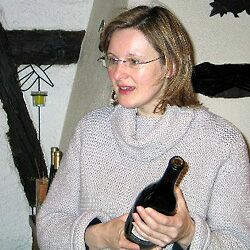 |
| Sylvie Boxler |
Being in Niedermorschwihr, we stopped for lunch at a favorite eatery, Caveau Morakopf. We always come here to check Munster pie off of our list of obligatory foods to eat while in Alsace. They also do a nice job with choucroute as well. Requisite pichets of Gewurztraminer and Riesling accompanied the meal.
Wednesday afternoon was devoted to hiking to Hunawihr to visit the Holy Grail, the Clos Ste. Hune Vineyard, a celebrated property owned by the Trimbach family for over 200 years. The soil is very stony argilio-calcaire-limestone. The highly regarded Clos Ste. Hune Vineyard is part of the larger Rosacker Vineyard. It is worth noting that the name Rosacker does not appear on the label of Clos Ste. Hune wines. A nap was also on the agenda as well, which is a true luxury in today´s hectic, multi-tasking world. Wednesday night was an encore at Le Bistrot. I love that tarté flambé!
Thursday
We tried to arrange a visit with Schoffit today but there were schedule conflicts, so the day was devoted to touring about, no wineries and no agenda. We decided to drive to Munster, known for its rich, creamy and exceptionally smelly cheese, the highlight of many an Alsatian meal. We walked around the town visiting the quaint shops and stopping for coffee. Of course we had to have some Munster cheese vacuum packed to be enjoyed at a later date, ahem.
We stopped in Turckheim for lunch at Restaurant Auberge du Veilleur à Turckheim. They had rabbit on the menu, which we all cast our bid on. Unfortunately, it was not to be, as they had run out. Instead we choose the ham shank with mustard offering, which turned out to be delicious. You could cut the meat with a fork. The shank filled half of the plate and was easily enough for two people. Let the belt out another notch.
The afternoon was spent shopping in Ribeauvillé before we returned to the hotel for another nap. The evening meal was a repeat of Tuesday night. I just can´t say enough about the food and service at Sarment d´Or. Of course that Grand Marnier soufflé still had my name on it. Holy smokes, I´ve only got one notch left in the belt.
Friday
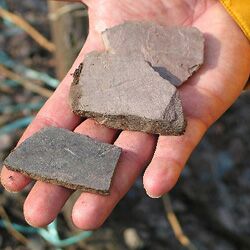 |
| German "terroir" |
Our final destination lay 60 kilometers to the north, the community of Ürzig. The drive upriver is simply awe-inspiring. Vine-terraced hillsides rise at seemingly impossible angles. It is easy to understand terroir when you look at the blue/grey Devonian slate soil of the vineyards.
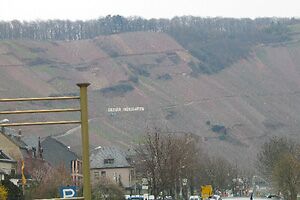 |
| Urziger Wurzgarten vineyard |
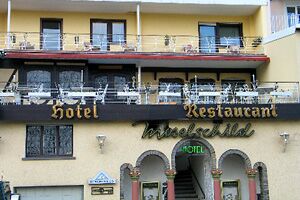 |
| Hotel Moselschild |
While not up to Alsatian standards, the dinner dishes were very tasty indeed. My fillet of sole was about as good as it gets. Hyllus recommended a few house Rieslings that went well with the various dinner selections. We also ordered a 1967 Merkelbach Ürziger Würzgarten feine Auslese from the extensive wine list. Oh my, adjectives do not do justice to the wine, so I won´t even try. We retired for the night well-sated.
Saturday
After a lovely breakfast at the Moselschild, we were off to Piesport to visit the Reinhold Haart Estate.
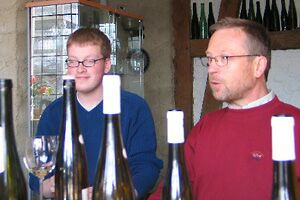 |
| Theo Haart and son |
Their famous Goldtröpfchen vineyard (adjacent to the wine estate) has quite a history. A large Roman wine press and an ornate Roman drinking vessel dating back to the third century were unearthed here. The deep, clayish slate soil at the site provides ample moisture during the dry, hot summers. The Riesling grapes are hand harvested about two weeks after the normal harvest has begun, with yields limited to 50 hl/ha. The grapes have at least five degrees more Oechsle per category than prescribed by German law.
Haart poured four Spatlese and three Auslese wines for us, all current releases with the exception of a ten-year-old Auslese. He wanted to show us the evolution of his wine, even from a vintage “only’ rated as very good. The wines were all very good to excellent (notes follow). Haart was not set up to sell wine directly. This was a good thing as our shippers were full. We made a note to find these wines back home even though Haart stated that a large portion of his wines go to Japan.
The afternoon was spent leisurely wandering the streets and shops of Bernkastel-Kues. The historic Bernkastel market square dates back to the middle ages. Coffee and pastries at a local shop tided us over on our return to Ürzig.
Dinner was an encore at the Moselschild, again with a bevy of Rieslings to wash everything down. We then called it an evening due an early start the next day.
Sunday
As it is with all good things, the end of our trip came much too quickly. Knowing that we were leaving early, the hotel prepared us an early breakfast. This was certainly unexpected but much appreciated. Hyllus had highlighted an expeditious route from Ürzig to the Frankfurt airport on our map the night before we left. She stated that the trip would take three hours or less. She was spot on.
Winging our way home we had plenty of time to reflect back on our trip. The fact that Alsace is one of the finest food and wine regions in the world was once again driven home. The fact that an extended return visit to the Mosel is in order was also made quite apparent. The food, the wine, the scenic beauty, and the warm, friendly people will not soon be forgotten.
Tasting Notes
Following are my abbreviated impressions on 63 wines, mostly current releases or soon to be released wines. Prices listed are those that I could find listed in the United States. Prices at the wineries were much cheaper, but that does not include international shipping charges, tariffs, etc. If I could only get those winery prices locally ... sigh.
Alsace
2002 Boxler, Gewurztraminer, Alsace, France, $NA. Aromas of dried roses and lychee are obvious. Similar flavors are supported by modest acidity; 86.
2002 Boxler, Gewurztraminer, Brand, Alsace, France, $NA. Light gold, with a classic nose of lychee fruit and rose petals. Lightly sweet, with a complex palate of minerals, roses, lychee, and peaches; 90.
2000 Boxler, Gewurztraminer, Sélection de Grains Nobles, Alsace, France, $NA. Medium gold with dried roses and lychee notes, this SGN is very sweet without being cloying. The wine coats the palate with a thick layer of fruit complexity and does not turn loose for an extended period. Just lovely; 92.
2002 Boxler, Pinot Blanc, Alsace, France, $NA. Golden straw in color. Lean, crisp, with aromas and flavors of peaches and pears; 87.
2002 Boxler, Pinot Blanc, (B), Alsace, France, $NA. This has more of a steely presentation, with minerals adding interest to the peach fruit. This begs for Shrimp Francis; 88.
2002 Boxler, Riesling, Brand Grand Cru, Alsace, France, $NA. Light gold in color. The mineral, peach, and cream aromas repeat on the palate, finishing with a long, lemony finish; 91.
2002 Boxler, Riesling, Sommerberg Grand Cru, L 31, Alsace, France, $NA. The wine shows a lot of minerality, peach fruit, and steely acidity. There is a long finish of flint, peaches, and lemons; 92.
2002 Boxler, Riesling, Sommerberg Grand Cru, L 31 D, Alsace, France, $NA. The grapes come from 65 y/o vines growing in granite and chalk soil. Botrytis, minerals, peaches and pears fill the nose. Slightly sweet, the wine is full and flavorful, with load of tart peaches and minerals; 93.
2002 Boxler, Riesling, Sommerberg Grand Cru, L 31 E, Alsace, France, $NA. The grapes came from 30 y/o vines and saw botrytis (but were fermented dry). Heavy minerals and peaches on the nose. Less steely and very intense on the palate, there is a full finish with tropical notes; 93.
2002 Boxler, Riesling, Sommerberg Grand Cru, L 31 JV, Alsace, France, $NA. Peaches abound on the nose. More of a fruit driven wine, it is full on the palate with bright acidity; 90.
2000 Boxler, Riesling, Sommerberg, Vendages Tardive, Alsace, France, $NA. Light gold, with intense aromas that draw you in. Nicely balanced. This is not as sweet as many VTs which makes it a nice match for rich Thai dishes; 90.
1998 Boxler, Tokay Pinot Gris, Alsace, France, $NA. Straw gold in color. The nose can best be described as smoked crème brule. Soft, sweet, with smoky ripe peach flavors; 86.
2002 Boxler, Tokay Pinot Gris, Alsace, France, $NA. There was a lot of trouble with rain, so grapes were selected cluster by cluster, with 50% of the crop discarded. The nose and palate are loaded with peaches and pears, with a lingering finish of canned pineapple; 87.
2002 Boxler, Tokay Pinot Gris, Brand, Alsace, France, $NA. Light gold, with aromas of minerals, tropical fruit, and leesy notes. Quite crisp, the lingering tropical fruit flavors beg for grilled trout or Thai food; 90.
1999 Boxler, Tokay Pinot Gris, Vendages Tardive, Alsace, France, $NA. The nose is a heady mix of almonds, pears, and citrus. Bright acidity balances out the sweetness. Flavors mirror the nose; 90.
1999 Boxler, Tokay Pinot Gris, Brand, Vendages Tardive, Alsace, France, $NA. A stunning wine that is moderately sweet with perfect balancing acidity. There are loads of complex aromas and flavors, botrytis, peaches and smoke being most prevalent; 94.
2001 Boxler, Sylvaner, Alsace, France, $NA. Crisp, refreshing, with aromas and flavors of Bartlett pear. Think oysters; 88.
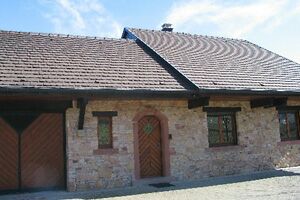 |
| Kientzler winery |
2000 Kientzler, Gewurztraminer, Alsace, France, $NA. This is fantastic for an entry level wine. Lots of tasty apricots and figs, with great acidity for this grape; 91.
2000 Kientzler, Gewurztraminer, Reserve Particulière, Alsace, France, $NA. I got so busy talking to Kientzler that I neglected writing a note. He states that they blend some of their VT back into this wine to make the reserve. It was tasty.
1989 Kientzler, Gewurztraminer, Sélection de Grains Nobles, Alsace, France, $NA. This one was opened to let us see how their SGN ages (well I might add). The nose and palate are a complex mix of filberts, cocoa, coffee, and baklava. Stunning stuff; 94.
1998 Kientzler, Gewurztraminer, Vendages Tardive, Alsace, France, $NA. Kientzler says that these grapes come from a low-yielding site known for botrytis formation. Imagine baklava with juniper overtones, and then lay on a layer of dazzling acidity. Almond and peach overtones linger; 93.
2001 Kientzler, Muscat, Alsace, France, $12. We´re talking gooseberries here. Dry, with brisk acidity, this is a good food wine, especially with white asparagus; 87.
2000 Kientzler, Muscat, Kirchberg Grand Cru, Alsace, France, $NA. Similar to their regular Muscat, but with more floral notes and complexity, although a tad softer on the palate; 89.
2002 Kientzler, Pinot Auxerrois, “K,’ Alsace, France, $NA. This grape is often sold under the name of Pinot Blanc d'Alsace. Delicately sweet, with some light spicy notes. Oysters Rockefeller come to mind; 88.
2001 Kientzler, Pinot Blanc, Alsace, France, $11. Nice, crisp acidity gives life to the classic Pinot Blanc flavors. Lingering finish. Pair with shrimp and oyster dishes; 87.
2000 Kientzler, Riesling, Alsace, France, $NA. Wow! What a nice low-end Riesling. Classics flavors had me wishing for a plate of escargot; 88.
2000 Kientzler, Riesling, Giesberg Grand Cru, Alsace, France, $NA. Kientzler said they could have sold this as an SGN but did not. Intense on the nose and palate, with petrol nuances and gripping acidity, this wine is just stunning; 95.
2001 Kientzler, Riesling, Giesberg Grand Cru, Alsace, France, $NA. Perfect for Thai food fans. This is a class act wine with spirited acidity, great minerality, and yummy citrus and pear fruit. Delightful; 92.
2001 Kientzler, Riesling, Osterberg Grand Cru, Alsace, France, $NA. You´ll find plenty of chalky minerals on the palate. The fruit profile/flavors remind me of Frederick Emile; 88.
2002 Kientzler, Riesling, Reserve Particulière, Alsace, France, $16. Great minerals and petrol on the nose and palate. This is an overachiever at a very fair price. Often contains declassified Grand Cru grapes; 90.
2002 Kientzler, Tokay Pinot Gris, Alsace, France, $NA. This is a classic Pinot Gris that will make a great food wine. Refreshing acidity breathes life into the peachy fruit flavors. The fruity finish seems endless; 91.
2001 Kientzler, Tokay Pinot Gris, Kirchberg de Ribeauvillé Grand Cru, Alsace, France, $NA. Almonds, peaches, and apricots define this wine, which is softer in the mouth than some of their other releases; 90.
2001 Kientzler, Tokay Pinot Gris, Reserve Particulière, Alsace, France, $NA. Fruit tart flavors combine with smoky caramel and great acidity to make a delightful wine. This is a perfect match for foie gras; 92.
2001 Trimbach, Gewurztraminer (Basic Label), Alsace, France, $14. A floral and grapefruity nose leads to more of same in the mouth. Full, with nice acidity, the lengthy aftertaste reminds you of grapefruit zest; 89.
2000 Trimbach, Gewurztraminer, Reserve, Alsace, France, $NA. More weighty on the palate than the entry level wine, this is a classic Gewurzt with lots of lychee fruit and roses, as well as more residual sugar; 90.
1999 Trimbach, Gewurztraminer, Cuvee des Seigneurs de Ribeaupierre, Alsace, France, $NA. The style of this wine has more of a grapefruit presentation and less floral qualities. Fleshy, soft, complex, with a lot of spice and yes, even a blueberry note or two; 91.
1998 Trimbach, Gewurztraminer, Vendages Tardive, Alsace, France, $55. Pure honey on the nose, with nice body and balance. Full, rich and honeyed, this is not as sweet as some VTs. It will pair perfectly with foie gras; 88.
1989 Trimbach, Gewurztraminer, Sélection de Grains Nobles, Alsace, France, $NA. Wow! This is sensory overload. Dark gold in color, with honey and musk on the nose. Intense, almost overpowering, sweet, with smoky honey lingering on the finish; 92.
2001 Trimbach, Pinot Blanc, Alsace, France, $10. Lean and crisp, the aromas of lemon, citrus, and fig carry over to the palate along with crème brule; 88.
2001 Trimbach, Pinot Gris, Reserve, Alsace, France, $15. Peaches and juicy pears fill the nose. Full in the mouth and tart. Similar flavors pervade the palate, finishing on a steely note; 89.
1999 Trimbach, Pinot Gris, Reserve Personnelle, Alsace, France, $33. A step up from the reserve, with more intensity of peaches, apricots, and pears. The wine is rich and mouth-coating; 91.
2002 Trimbach, Riesling (Basic Label), Alsace, France, $15. Following the house style, the wine is clean and crisp, with apricot and citrus notes. Drink young; 86.
2001 Trimbach, Riesling, Reserve, Alsace, France, $NA. The nose screams of minerals, peaches, and apricots. More flesh and intensity than the basic Riesling. Citrus and fig flavors linger on this wine; 89.
2000 Trimbach, Riesling, Cuveé Frédéric Emile, Alsace, France, $NA. Deep, intense aromas of apricots and minerals are striking. A definite step up from the Reserve, the wine is steely and flinty, with complex layers of flavors unfolding; 93.
1999 Trimbach, Riesling, Cuveé Frédéric Emile, Alsace, France, $33. Minerals and white peaches manifest themselves freely on the nose. True to the house style, there is steely acidity and flint, but less complexity than the 2000 offering; 89.
2002 Weinbach, Gewurztraminer, Cuvee Laurence, Altenbourg, Alsace, France, $60. Classic lychee and rose petals aromas fill the nose. Impeccably balanced, the wine is complex in the mouth, with a long, lengthy finish that has a sense of sweetness; 90.
2002 Weinbach, Gewurztraminer, Cuvee Laurence, Furstentum, Alsace, France, $48. The best way to describe the nose is crystallized oranges. Like the Altenbourg, there is very nice balance, with complex fruit flavors and sweet delights; 91.
2001 Weinbach, Gewurztraminer, Furstentum, Vendages Tardive, Alsace, France, $84. The nose is a very intense mix of rose oil and lychee fruit. Very sweet, balanced, but not heavy. Extremely long aftertaste; 93.
2002 Weinbach, Muscat Réserve, Alsace, France, $33. Pears, almonds, and peaches are presented on the nose. The wine is lean, crisp, and bright, with flavors mirroring the nose. Think asparagus blanc or a vegetable terrine here; 88.
2002 Weinbach, Tokay Pinot Gris, Cuvee Catherine, Alsace, France, $48. Light gold, with an air of smokiness and mixed fruit. Sleek, with deft balance, the delicately sweet wine has loads of peaches and pears in swirls of complexity; 90.
2002 Weinbach, Tokay Pinot Gris, Cuvee Laurence, Alsace, France, $54. The vines grow on limestone and clay which results in minerality on the nose and palate. Not a heavy wine, but great acidity. Honey, almonds, peaches, and pears all intermingle to delight the senses; 91.
2002 Weinbach, Riesling, Cuvee Catherine, Schlossberg Grand Cru, Alsace, France, $54. This is a very balanced wine, with peaches, pears, flint, and a hint of sweetness. The wine has a dry finish with a hint of petrol; 91.
2002 Weinbach, Riesling, Cuvee Catherine, Schlossberg, L´Inédit!, Alsace, France, $60. Faller said that the grapes for this wine come from vines are sixty-years-old and grow on sandy soil over granite. Very full, rich, and silky. The honey and lemon nose morphs into intense mango and canned pineapple flavors which are perfect for Thai dishes; 93.
2001 Weinbach, Riesling, Schlossberg, Vendages Tardive, Alsace, France, $96. This golden beauty emits a fragrance of orange blossoms and peaches. Very intense on the palate, sweet but not cloying, with floral notes, orange zest, and white peaches; 92.
Germany
 |
| Vineyards overlooking the Mosel |
2002 Reinhold Haart, Dhronhofberger Riesling Spätlese, Mosel, Germany, $NA. The nose is a pleasant mix of peaches, pears, and cotton candy. Nicely balanced, brisk acidity, and flavors mirroring the nose; 89.
2002 Reinhold Haart, Piesporter Goldtröpfchen Riesling Spätlese, Mosel, Germany, $28. Lots of stone and slate add to the peach and honey aromas. Fruity, crisp, and well-balanced, you´ll find a lingering aftertaste of ripe pears; 90.
2001 Reinhold Haart, Piesporter Goldtröpfchen Riesling Spätlese, Mosel, Germany, $33. Gunpowder, flint, peaches, and pears carry from nose to palate. Pineapple and honeyed notes linger on the palate. Delightful; 91.
2002 Reinhold Haart, Piesporter Goldtröpfchen Riesling Auslese, Mosel, Germany, $38. Pears and botrytis are apparent on the nose. Full and intense on the palate, the sweet peach and mango fruit lingers endlessly; 91.
1994 Reinhold Haart, Piesporter Goldtröpfchen Riesling Auslese, Mosel, Germany, $NA. Lots of slate, peaches, pears, and honey are upfront. Sweet and balanced, with notes of honey and cashews. Ripe peaches linger on the long finish; 93.
2002 Reinhold Haart, Wintricher Ohligsberg Riesling Spätlese, Mosel, Germany, $NA. Light gold in color, with a nose of gunpowder and peaches which carry over to the palate, with the addition of Bartlett pears; 88.
2002 Reinhold Haart, Wintricher Ohligsberg Riesling Auslese, Mosel, Germany, $50. Very rich and balanced, this light gold Riesling is the very essence of ripe peaches and honey, both on the nose and on the palate; 92.




